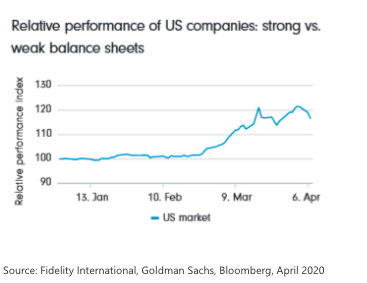28th April 2020
How to think about dividend cuts
- In the 2008 global financial crisis, dividends were cut by over 20 per cent on average, a figure likely to be more than doubled in this downturn.
- This shouldn’t alter the long-term outlook for what are otherwise solid businesses
- Firms with the strongest balance sheets, those that are also best positioned to resist pressure on dividends are already showing signs of relative outperformance
- Asian dividend stocks have outperformed the broader region after previous selloffs
Focus on fundamentals - Matthew Jennings, investment director, Equities, Fidelity International
“In normal times, dividend cuts can signal a company in distress. But when it’s the economy itself that’s in distress, cutting or delaying dividend payments can be a sign of corporate prudence.
“Companies around the world are tightening purse strings as they brace for a global recession in the wake of the Covid-19 pandemic. Some, like financial institutions in the UK, Europe and New Zealand, are acting on instructions from their regulators. Others are responding protectively to an actual or feared reduction in cashflows. And some others are delaying because social distancing means they’ve been unable to hold shareholder meetings to formally approve their payouts.
“Still, not all companies are trimming dividends. Many firms are going ahead with payments as planned, while some have even announced increased payouts - a contrarian trend that’s notable in several global markets including China (more on this below). In Europe, there are examples of stable businesses within sectors like pharmaceuticals, consumer staples and industrials where we expect dividends to be relatively safe.
“But the fact remains that dividends are under pressure globally. In the 2008 global financial crisis, dividends were cut by over 20 per cent on average, a figure likely to be more than doubled in this downturn.
“Investors focused on the regular income distributions that higher dividend stocks can offer may find the size and frequency of these payments delayed or disrupted due to Covid-19. But this won’t be the case across all companies.
“Equity is a long duration asset and a single year’s dividend is not a major part of the intrinsic value of a business. In this environment, where indiscriminate selling is producing huge dislocations to valuations, being able to identify the well-run and well-capitalised companies is key, as these are likely to emerge in a position of relative strength on the other side of this crisis. Indeed, firms with the strongest balance sheets, those that are also best positioned to resist pressure on dividends (see Chart 1), are already showing signs of relative outperformance.”
Chart 1: Companies with strong balance sheets are outperforming
“Markets have been moving through an unprecedented crisis and still have some distance to go before the Covid-19 pandemic stabilises. For investors, especially those focused on investing for steady income, where dividends are a key part of many strategies, these are unsettling times. Many companies globally are reducing or delaying payouts. We expect more near-term disruption, but this shouldn’t alter the long-term outlook for what are otherwise solid businesses.
“There are a wide range of reasons why dividend payments come under pressure - and in many cases, cutting payouts is a perfectly prudent response to the current situation. But not all companies are responding to this pressure in the same way, and we’re seeing some notable exceptions, for example in Asia or within certain more resilient sectors in Europe, where companies are leaning against the trend. The key differentiator for most company managements will be the resilience of their cash flows, strength of their balance sheets and sustainability of their dividend policies.”
Contrarian China - Jochen Breuer, Portfolio Manager, Fidelity International
“Asian dividend stocks have outperformed the broader region after previous selloffs (see Chart 2). And within greater China, many big companies were steady dividend payers through previous rounds of market turbulence, including firms like chipmaker TSMC (which paid out $8.4 billion in dividends last year), CK Infrastructure, developer Sun Hung Kai Properties, or conglomerate Guangdong Investment.
“There has been a particular focus among companies from mainland China, specifically those that count the state as a major investor, on increasing dividend payouts in recent years. This follows sustained calls by the government to increase shareholder returns.
“Recent examples include telecom giant China Mobile; Shenhua Energy, the country’s biggest coal producer; and state-backed property developer China Overseas Land and Investment, or COLI. All three companies recently announced dividend increases.
“Despite a 9.5 per cent net profit decline, China Mobile slightly increased its full-year dividend payment for 2019 by 3.4 per cent, while assuring investors that it will maintain a stable dividend for the full year of 2020. The management cited shareholder returns as the reason for its decision to boost the payout from last year. Shenhua, sitting on a large cash pile, bumped up its payout ratio to 60 per cent from 40 per cent, while pledging a floor of 50 per cent for 2020 and 2021. And developer COLI proposed a final dividend that lifted its payments for the full year by 13.3 per cent, slightly more than the annual increase in net profit.
“China’s securities regulator has repeatedly called for greater rewards for shareholders in the form of dividend payments, as the government seeks to encourage fundamental investing as part of a drive to reform the stock market.
“Generally, state-owned enterprises with strong cashflow are more likely to heed the call. Their cash distributions help to boost the coffers of various government units that hold SOE shares, especially in a slowing economy. Big dividend payers tend to include the largest SOEs, which are often financial firms, energy producers and real estate developers with cyclical profits. Many of them still have strong balance sheets this year that allow resilient distributions. Nevertheless, profit outlooks for Chinese companies in general remain challenging, with the Covid-19 outbreak hurting both exports and domestic consumption. Many other Chinese firms with weak cashflows are cutting or suspending dividends, just like their global peers.”


